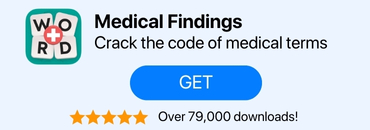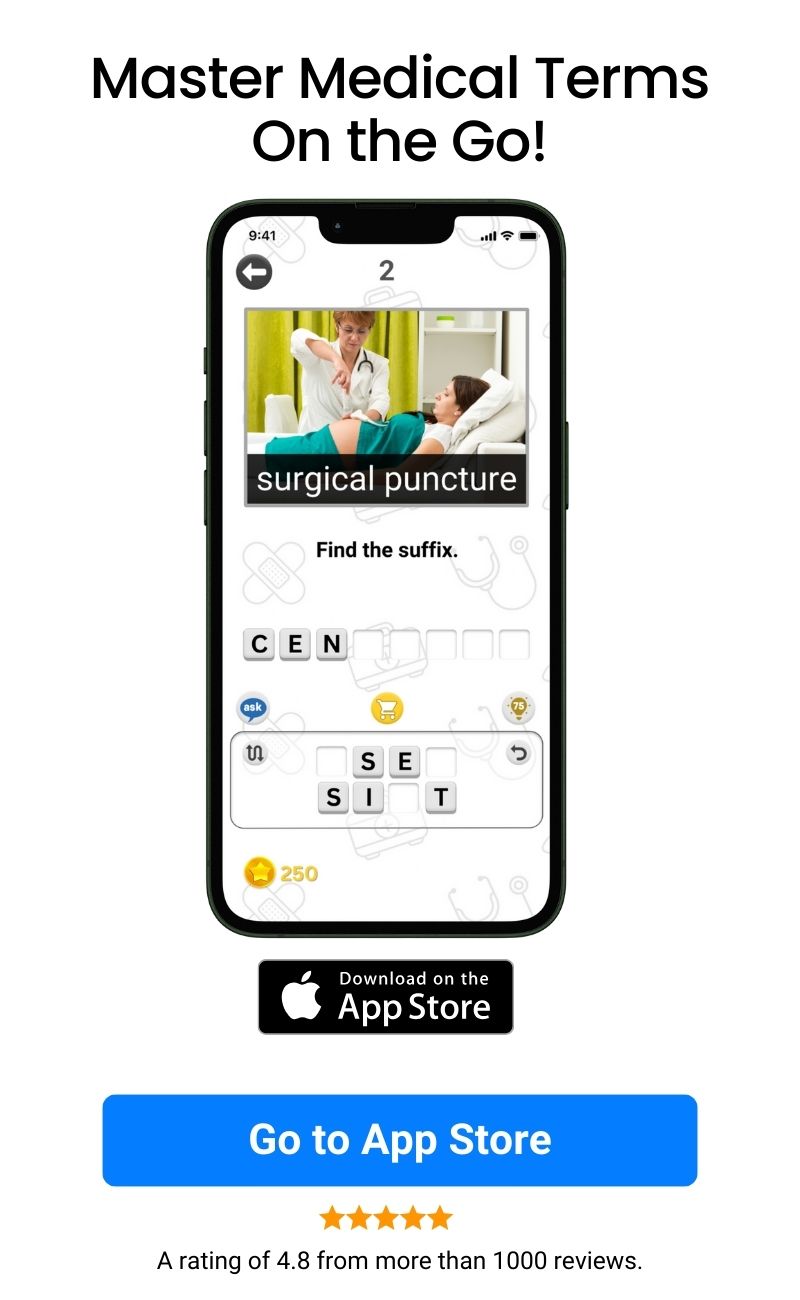Taking this quiz will allow you to learn and familiarize yourself with the combining forms and word roots pertaining to Cardiovascular System.
Quick Review for the Quiz
Check out the flashcard version for a more detailed review.
| Word Root | Combining Form | Body Part or Condition |
|---|---|---|
| angi, vas, vascul | angi/o, vas/o, vascul/o |
vessel (usually blood vessel)
|
| aort | aort/o | aorta |
| arter, arteri | arter/o, arteri/o | artery |
| arteriol | arteriol/o | arteriole |
| ather | ather/o | fatty plaque |
| atri | atri/o | atrium |
| cardi | cardi/o | heart |
| hemat, hem | hemat/o, hem/o | blood |
| isch | isch/o | blockage |
| myel | myel/o |
bone marrow (also refers to spinal cord)
|
| plasm | plasm/o | plasma |
| thromb | thromb/o | clot |
| valv, valvul | valv/o, valvul/o | valve |
| ven, ven, phleb | ven/o, ven/i, phleb/o | vein |
| ventricul | ventricul/o | ventricle |
-
Question of
Find the combining form shown in the image.

-
angi/o or vas/o
-
isch/o
-
hemat/o or hem/o
-
aort/o
Correct Wrong
angi/o, vas/o or vascul/o is a combining form that pertains to "vessel (usually blood vessel)". A blood vessel is a channel that transports blood to body tissues. A blood vessel can be classified as an artery, capillary, or vein depending on its structure and function.
-
-
Question of
Find the combining form shown in the image.

-
aort/o
-
ven/o or phleb/o
-
valv/o or valvul/o
-
arteriol/o
Correct Wrong
aort/o is a combining form that pertains to "aorta". Located near the heart, the aorta is the largest artery that carries blood away from the heart to other parts of the body.
-
-
Question of
Find the combining form shown in the image.

-
arter/o or arteri/o
-
plasm/o
-
isch/o
-
hemat/o or hem/o
Correct Wrong
arter/o, arteri/o is a combining form that pertains to "artery". An artery is a type of blood vessel that carries oxygenated blood from the heart to the organs and tissues of the body.
-
-
Question of
Find the combining form shown in the image.

-
arteriol/o
-
plasm/o
-
atri/o
-
cardi/o
Correct Wrong
arteriol/o is a combining form that pertains to "arteriole". The arteriole is a small blood vessel that is part of the microcirculation, which extends from the artery and leads to capillaries.
-
-
Question of
Find the combining form shown in the image.

-
ather/o
-
hemat/o or hem/o
-
cardi/o
-
ven/o or phleb/o
Correct Wrong
ather/o is a combining form that pertains to "fatty plaque". Atherosclerosis refers to the accumulation of fats, cholesterol, and other substances within and on the walls of your arteries.
-
-
Question of
Find the combining form shown in the image.

-
atri/o
-
cardi/o
-
valv/o or valvul/o
-
angi/o or vas/o
Correct Wrong
atri/o is a combining form that pertains to "atrium". As one of the two upper chambers of the heart, the atrium receives blood from the circulatory system. The heart has two atria - the left atrium receives blood from the pulmonary circulation while the right atrium is supplied by the systemic circulation's vena cavae.
-
-
Question of
Find the combining form shown in the image.

-
cardi/o
-
isch/o
-
thromb/o
-
angi/o or vas/o
Correct Wrong
cardi/o is a combining form that pertains to "heart". Located at the base of your chest, the heart is a fist-sized organ that pumps your blood throughout the body. The heart is the main organ of your circulatory system.
-
-
Question of
Find the combining form shown in the image.

-
hemat/o or hem/o
-
thromb/o
-
angi/o or vas/o
-
plasm/o
Correct Wrong
hemat/o or hem/o is a combining form that pertains to "blood". Blood is a complex body fluid made up of four main components: plasma, red blood cells, white blood cells, and platelets. Among its many functions, blood carries oxygen and nutrients to the lungs and tissues, forms blood clots to prevent excessive blood loss, and transports cells and antibodies that fight infections.
-
-
Question of
Find the combining form shown in the image.

-
isch/o
-
arter/o or arteri/o
-
ather/o
-
cardi/o
Correct Wrong
isch/o is a combining form that pertains to "blockage". A condition known as ischemia refers to a blocked blood vessel, which reduces blood flow or stops it entirely.
-
-
Question of
Find the combining form shown in the image.

-
myel/o
-
ather/o
-
ven/o or phleb/o
-
arter/o or arteri/o
Correct Wrong
myel/o is a combining form that pertains to "bone marrow" or can also refer to "spinal cord". Bone marrow consists of the soft, spongy tissue that has many blood vessels, and it is found at the center of most bones. The two main types of bone marrow are red and yellow.
-
-
Question of
Find the combining form shown in the image.

-
plasm/o
-
angi/o or vas/o
-
myel/o
-
aort/o
Correct Wrong
plasm/o is a combining form that pertains to "plasma". The plasma is the clear, yellowish, fluid portion of your blood that makes up about 55% of its volume. As the circulatory system moves, the plasma helps the body recover from injury, distribute nutrients, eliminate waste, and prevent infection.
-
-
Question of
Find the combining form shown in the image.

-
thromb/o
-
arteriol/o
-
cardi/o
-
ventricul/o
Correct Wrong
thromb/o is a combining form that pertains to "clot". A blood clot is formed when blood platelets, proteins, and cells stick together. A thrombus is a blood clot that attaches to the walls of a blood vessel. It is called an embolus if it moves through the bloodstream and blocks the flow of blood in another area of the body.
-
-
Question of
Find the combining form shown in the image.

-
valv/o or valvul/o
-
ven/o or phleb/o
-
ventricul/o
-
angi/o or vas/o
Correct Wrong
valv/o or valvul/o is a combining form that pertains to "valve". A heart valve is a flap that prevents blood from flowing backwards. The four heart valves that ensure blood flows in the right direction are the mitral, tricuspid, pulmonary, and aortic valves. During each heartbeat, the flaps (leaflets) of the valve open and close.
-
-
Question of
Find the combining form shown in the image.

-
ven/o or phleb/o
-
ather/o
-
aort/o
-
atri/o
Correct Wrong
ven/o, ven/i or phleb/o is a combining form that pertains to "vein". A vein is a blood vessel that carries deoxygenated blood from the tissues back to the heart. The pulmonary vein and umbilical vein, which carry oxygenated blood to the heart, are exceptions. Compared to arteries, veins are less muscular and are often located closer to the skin.
-
-
Question of
Find the combining form shown in the image.

-
ventricul/o
-
ven/o or phleb/o
-
cardi/o
-
arteriol/o
Correct Wrong
ventricul/o is a combining form that pertains to "ventricle". A ventricle can pertain to a chamber of the heart or a section of the brain. The heart ventricle is one of two large chambers near the bottom of the heart where blood collects and travels to the lungs and other parts of the body.
-




